Hand and Wrist Treatment and Surgery
Are you searching for the best hand, and wrist specialist in India? Are you looking to consultant online with the best Hand and wrist doctor in delhi? Do you want to consult online with the best hand and wrist specialist? Are you searching for health-medic solutions related to hand and wrist? Do you want to Book an online appointment with Wrist Pain Doctors in Delhi NCR? Are you looking for the Best Hand injury surgeon in delhi? For all your orthopedic-related treatments and surgery; Dr. Rahul Sharma is one of the best hand and wrist doctor in Delhi experience with more than 15 years. Discover experienced hand wrist surgeons to fix the scaphoid fracture percutaneously in India from Life In Motion Clinic, a pioneer orthopaedic hospital book an online appointment with one of the best hand and wrist surgeon in Delhi, India.
Know Hand & Wrist Anatomy
The human hand is made up of the wrist, palm, and fingers and consists of 27 bones, 27 joints, 34 muscles, over 100 ligaments and tendons, and many blood vessels and nerves.
The hands enable us to perform many of our daily activities such as driving, writing and cooking. It is important to understand the normal anatomy of the hand to learn more about diseases and conditions that can affect our hands. Life In Motion Clinic is a team of 16+ hand wrist doctors and surgeons who promise high-quality driven orthopedic services to ensure affordable access regarding all orthopedic healthcare services.
Bones
The wrist is comprised of 8 carpal bones. These wrist bones are attached to the radius and ulna of the forearm to form the wrist joint. They connect to 5 metacarpal bones that form the palm of the hand. Each metacarpal bone connects to one finger at a joint called the metacarpophalangeal joint or MCP joint. This joint is also commonly referred to as the knuckle joint.
The bones in our fingers and thumb are called phalanges. Each finger has 3 phalanges separated by two interphalangeal joints, except for the thumb, which only has 2 phalanges and one interphalangeal joint.
The first joint close to the knuckle joint is called the proximal interphalangeal joint or PIP joint. The joint closest to the end of the finger is called the distal interphalangeal joint or DIP joint.
The MCP joint and the PIP joint act like hinges when the fingers bend and straighten.
Soft Tissues
Our hand bones are held in place and supported by various Soft Tissues. These include articular cartilage, ligaments, muscles and tendons.
Articular cartilage is a smooth material that acts as a shock absorber and cushions the ends of bones at each of the 27 joints, allowing smooth movement of the hand.
Muscles and ligaments function to control the movement of the hand.
Ligaments are tough rope-like tissue that connects bones to other bones, holding them in place and providing stability to the joints. Each finger joint has two collateral ligaments on either side, which prevents the abnormal sideways bending of the joints. The volar plate is the strongest ligament in the hand. It joins the proximal and middle phalanx on the palm side of the joint and prevents backwards bending of the PIP joint (hyperextension).
Muscles
Muscles are fibrous tissues that help produce movement. Muscles work by contracting.
There are two types of muscles in the hand, intrinsic and extrinsic muscles.
Intrinsic muscles are small muscles that originate in the wrist and hand. They are responsible for the fine motor movement of the fingers during activities such as writing or playing the piano.
Extrinsic muscles originate in the forearm or elbow and control the movement of the wrist and hand. These muscles are responsible for gross hand movements. They position the wrist and hand while the fingers perform fine motor movements.
Each finger has six muscles controlling its movement: three extrinsic and three intrinsic muscles. The index and little finger each have an extra extrinsic extensor.
Tendons
Tendons are Soft Tissues that connect muscles to bones. When muscles contract, tendons pull the bones causing the finger to move. The extrinsic muscles attach to finger bones through long tendons that extend from the forearm through the wrist. Tendons located on the palm side help in bending the fingers and are called flexor tendons, while tendons on the top of the hand help in straightening the fingers, and are called extensor tendons.
Nerves
Nerves of the hand carry electrical signals from the brain to the muscles in the forearm and hand, enabling movement. They also carry the senses of touch, pain and temperature back from the hands to the brain.
The three main nerves of the hand and wrist are the ulnar nerve, radial nerve and median nerve. All three nerves originate at the shoulder and travel down the arm to the hand. Each of these nerves has sensory and motor components.
Ulnar Nerve: The ulnar nerve crosses the wrist through an area called Guyon's canal and branches to provide sensation to the little finger and half of the ring finger.
Median Nerve: The median nerve crosses the wrist through a tunnel called the carpal tunnel. The median nerve provides sensation to the palm, thumb, index finger, middle finger, and part of the ring finger.
Radial Nerve: The radial nerve runs down the thumb side of the forearm and provides sensation to the back of the hand from the thumb to the middle finger.
Blood Vessels
Blood vessels travel beside the nerves to supply blood to the hand. The main arteries are the ulnar and radial arteries, which supply blood to the front of the hand, fingers, and thumb.
The ulnar artery travels next to the ulnar nerve through the Guyon's canal in the wrist.
The radial artery is the largest artery of the hand, travelling across the front of the wrist, near the thumb. Pulse is measured at the radial artery.
Other blood vessels travel across the back of the wrist to supply blood to the back of the hand, fingers, and thumb.
Hand Surgery Doctors in Delhi NCR is available at LMC LIfe In Motion Clinic. Book Online Appointment with Dr. Rahul Sharma Best Hand Surgeon Delhi India. LMC is the best Hand Surgery Clinic to discover the best-experienced Hand and Wrist Surgeon in India. Get Treatment for hand and wrist injuries in Delhi from the best doctors near you at Saket Delhi.
Bursae
Bursae are small fluid-filled sacs that decrease friction between tendons and bone or skin. Bursae contain special cells called synovial cells that secrete a lubricating fluid.
Conditions
-
Hand Pain
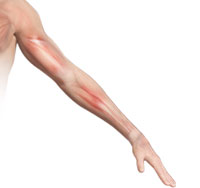 Hand pain is an unpleasant sensation in the joints and tissues of the hand or fingers. It can be depicted as pulsating, aching, increased warmth, prickling, irritation and inflexibility. The hand is composed of nerves, bones, blood vessels, muscles, tendons and skin.
Hand pain is an unpleasant sensation in the joints and tissues of the hand or fingers. It can be depicted as pulsating, aching, increased warmth, prickling, irritation and inflexibility. The hand is composed of nerves, bones, blood vessels, muscles, tendons and skin. -
Trigger Finger
 The ability to bend the fingers is governed by supportive tendons that connect muscles to the bones of the fingers. The tendons run along the length of the bone and are kept in place at intervals by tunnels of ligaments called pulleys.
The ability to bend the fingers is governed by supportive tendons that connect muscles to the bones of the fingers. The tendons run along the length of the bone and are kept in place at intervals by tunnels of ligaments called pulleys. -
Dupuytren’s Contracture
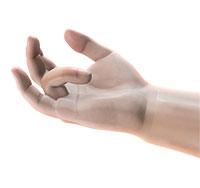 Dupuytren's Contracture is a hand condition where thickening of the underlying fibrous tissues of the palm cause the fingers to bend inward. Patients with this condition are unable to fully straighten the affected fingers.
Dupuytren's Contracture is a hand condition where thickening of the underlying fibrous tissues of the palm cause the fingers to bend inward. Patients with this condition are unable to fully straighten the affected fingers. -
De Quervain’s Tendinosis
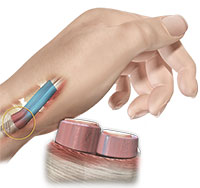 The muscles and bones of the hand are connected by thick flexible tissue called tendons. Tendons are covered by a thin soft sheath of tissue known as synovium. Extensor pollicis brevis and abductor pollicis longus are two tendons located on the thumb side of the wrist.
The muscles and bones of the hand are connected by thick flexible tissue called tendons. Tendons are covered by a thin soft sheath of tissue known as synovium. Extensor pollicis brevis and abductor pollicis longus are two tendons located on the thumb side of the wrist. -
Carpal Tunnel Syndrome
 Carpal Tunnel Syndrome is a common, painful, progressive condition that is caused by compression of the median nerve at the wrist area.
Carpal Tunnel Syndrome is a common, painful, progressive condition that is caused by compression of the median nerve at the wrist area. -
Wrist Injuries
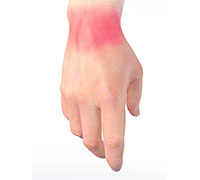 The wrist is more prone to injuries/problems that may include sprains and strains as well as fractures can occur with lifting and carrying heavy objects, wrist injury while operating machinery, bracing against a fall, or sports-related injuries.
The wrist is more prone to injuries/problems that may include sprains and strains as well as fractures can occur with lifting and carrying heavy objects, wrist injury while operating machinery, bracing against a fall, or sports-related injuries. -
Flexor Tendon Injuries
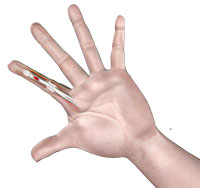 Tendons are the bands of fibrous connective tissue that connect muscles to bone. Tendons aid in the movement of the fingers, hand and all other body parts.
Tendons are the bands of fibrous connective tissue that connect muscles to bone. Tendons aid in the movement of the fingers, hand and all other body parts. -
Wrist Fracture
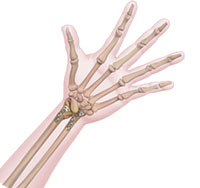 The wrist is comprised of two bones in the forearm, the radius and ulna, and eight tiny carpal bones in the palm. The bones meet to form multiple large and small joints. A wrist fracture refers to a break in one or more of these bones.
The wrist is comprised of two bones in the forearm, the radius and ulna, and eight tiny carpal bones in the palm. The bones meet to form multiple large and small joints. A wrist fracture refers to a break in one or more of these bones. -
Fractures of the Hand and Fingers
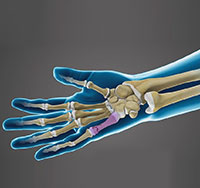 The hand is one of the most flexible and useful parts of our body. Because of overuse in various activities, the hands are more prone to injuries, such as sprains and strains, fractures and dislocations, lacerations and amputations while operating machinery, bracing against a fall and sports-related injuries.
The hand is one of the most flexible and useful parts of our body. Because of overuse in various activities, the hands are more prone to injuries, such as sprains and strains, fractures and dislocations, lacerations and amputations while operating machinery, bracing against a fall and sports-related injuries. -
Nailbed Injuries
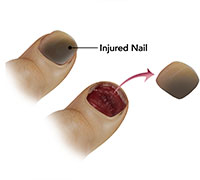 A nail is the hard covering at the end of the dorsal side of your fingers and toes. The nail is composed of a nail plate, nail matrix (a tissue that protects nails) and nail bed. The nail plate is a hard, translucent part of the nail composed of a protein called keratin.
A nail is the hard covering at the end of the dorsal side of your fingers and toes. The nail is composed of a nail plate, nail matrix (a tissue that protects nails) and nail bed. The nail plate is a hard, translucent part of the nail composed of a protein called keratin. -
Distal Radius Fracture
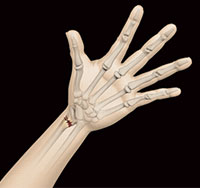 The forearm consists of two bones, the radius and ulna. The radius is the larger of the two forearm bones, and the region towards the wrist is called the distal end. Fractures in this end are most common.
The forearm consists of two bones, the radius and ulna. The radius is the larger of the two forearm bones, and the region towards the wrist is called the distal end. Fractures in this end are most common. -
Wrist Sprain
 Injuries caused due to stretching or tearing of the ligaments in the wrist are called wrist sprains. These injuries are usually caused by a fall during daily activities or sports activities. Sprains can range from mild to severe based on the extent of injury to the ligament.
Injuries caused due to stretching or tearing of the ligaments in the wrist are called wrist sprains. These injuries are usually caused by a fall during daily activities or sports activities. Sprains can range from mild to severe based on the extent of injury to the ligament. -
Tendon and Nerve Laceration
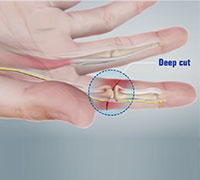 A laceration is a tear or ragged opening in the skin usually caused by an injury or trauma. A laceration may be either a partial laceration or a complete laceration. Tendons connect muscles to bones and allow coordinated movement of the joints. A deep cut or laceration on the palm side of the hand can damage the flexor tendons, which control movement in your hand.
A laceration is a tear or ragged opening in the skin usually caused by an injury or trauma. A laceration may be either a partial laceration or a complete laceration. Tendons connect muscles to bones and allow coordinated movement of the joints. A deep cut or laceration on the palm side of the hand can damage the flexor tendons, which control movement in your hand. -
Scaphoid Fracture
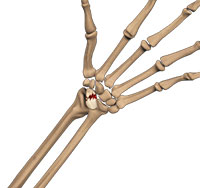 The scaphoid bone is a small, boat-shaped bone in the wrist, which, along with 7 other bones, forms the wrist joint. It is present on the thumb side of the wrist causing it to be at high risk for fractures. A scaphoid fracture is usually seen in young men aged 20 to 30 years. They can occur at two places: near the thumb or near the forearm.
The scaphoid bone is a small, boat-shaped bone in the wrist, which, along with 7 other bones, forms the wrist joint. It is present on the thumb side of the wrist causing it to be at high risk for fractures. A scaphoid fracture is usually seen in young men aged 20 to 30 years. They can occur at two places: near the thumb or near the forearm. -
Ganglion Cyst
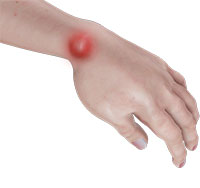 Ganglion cysts are swellings that most commonly develop along the tendons or joints of wrists or hands. They can be found either at the top of the wrist, palm side of the wrist, end joint of a finger, or at the base of a finger. A ganglion cyst is not cancerous and will not spread to the other parts of the body.
Ganglion cysts are swellings that most commonly develop along the tendons or joints of wrists or hands. They can be found either at the top of the wrist, palm side of the wrist, end joint of a finger, or at the base of a finger. A ganglion cyst is not cancerous and will not spread to the other parts of the body. -
Mallet Finger
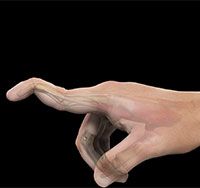 Mallet finger is a condition where the end of the finger is bent and does not straighten. It occurs when the extensor tendon on the back of the finger is damaged. The finger joint is a hinge joint that allows bending and straightening of the fingers. Each finger is composed of 3 phalanges bones, joined by 2 interphalangeal joints (IP joints).
Mallet finger is a condition where the end of the finger is bent and does not straighten. It occurs when the extensor tendon on the back of the finger is damaged. The finger joint is a hinge joint that allows bending and straightening of the fingers. Each finger is composed of 3 phalanges bones, joined by 2 interphalangeal joints (IP joints). -
Arthritis of the Hand and Wrist
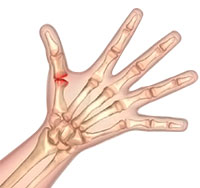 Arthritis is an inflammatory condition of joints. There are several types of arthritis and the most common type is osteoarthritis or wear-and-tear arthritis. Arthritis affects various joints in the body and arthritis in hand affects the joint at the base of the thumb.
Arthritis is an inflammatory condition of joints. There are several types of arthritis and the most common type is osteoarthritis or wear-and-tear arthritis. Arthritis affects various joints in the body and arthritis in hand affects the joint at the base of the thumb. -
Arthritis of the Thumb
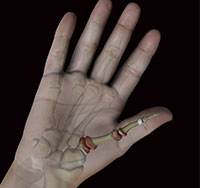 Arthritis is an inflammatory condition of joints. There are several types of arthritis; the most common type is osteoarthritis or wear-and-tear arthritis that affects the joint at the base of the thumb. Thumb arthritis is more common in women than men and usually occurs after the age of 40 years.
Arthritis is an inflammatory condition of joints. There are several types of arthritis; the most common type is osteoarthritis or wear-and-tear arthritis that affects the joint at the base of the thumb. Thumb arthritis is more common in women than men and usually occurs after the age of 40 years. -
Hand Infections
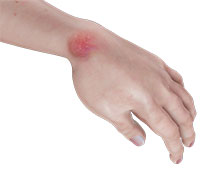 Hands become infected more frequently as it is one of the commonly injured parts of our body. Hand infections, if left untreated or treated improperly can cause disabilities such as stiffness, contracture, weakness, and loss of tissues (skin, nerve and bone) that persist even after the infection resolves.
Hands become infected more frequently as it is one of the commonly injured parts of our body. Hand infections, if left untreated or treated improperly can cause disabilities such as stiffness, contracture, weakness, and loss of tissues (skin, nerve and bone) that persist even after the infection resolves. -
Kienbock’s Disease
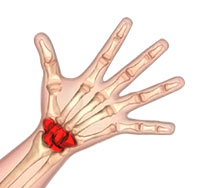 Kienbock's disease is a condition in which the lunate, one of the small bones of the wrist loses its blood supply leading to the death of the bone. This results in pain, stiffness, and degenerative changes in the wrist joint.
Kienbock's disease is a condition in which the lunate, one of the small bones of the wrist loses its blood supply leading to the death of the bone. This results in pain, stiffness, and degenerative changes in the wrist joint. -
Boutonniere Deformity
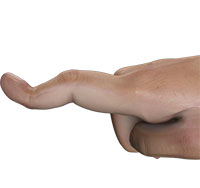 Tendons in your fingers connect the finger bones to finger muscles and help bend and straighten the finger at the joint when the muscles contract. Boutonnière deformity is a condition in which a tendon injury to the middle joint of the finger results in the inability to straighten the affected finger.
Tendons in your fingers connect the finger bones to finger muscles and help bend and straighten the finger at the joint when the muscles contract. Boutonnière deformity is a condition in which a tendon injury to the middle joint of the finger results in the inability to straighten the affected finger.
Procedures
We at Life In Motion Clinic Orthopaedic Hospital serving for the last 20 years in India. Here following hand surgeries are undertaken by India's best-experienced hand surgeons - Flexor and Extensor tendon surgery, Excision of Ganglion, Trigger finger/thumb release, Metacarpo-phalangeal and proximal inter-phalangeal joint replacement, Hand fractures and trauma, Dupuytren’s Surgery, Trapizectomy for thumb osteoarthritis, Deformity correction, Excision of soft tissue tumors, Metacarpo-phalangeal and proximal inter-phalangeal joint fusion, and Carpal Tunnel Decompression. Book an Online Appointment with Dr. Rahul Sharma hand wrist specialist to discuss more on treatments and surgery of hand and wrist.
At Life In Motion Clinic, experienced hand wrist specialists perform the following Wrist surgeries a few names of wrist surgeries are - Wrist arthrodesis, Distal radius osteotomy, Surgery for Keinbock’s disease, Wrist fractures, and trauma, Open reduction internal Fixation of Scaphoid fractures, and De’Quervains Release. Here you can also discover the best elbow surgeons who are specialists to perform following elbow surgeries - Cubital tunnel decompression, Elbow replacement surgery, Tennis and Golfers elbow release, and Radial tunnel decompression. Are you facing pain in the elbow, pain in the wrist, or pain in the hand? Book an online consultation with Dr. Rahul Sharma to get a cure for pain as we at Life In Motion believe that Surgery is the last option as medic and care available at LMC to solve Orthopaedic related health issues.
-
Non-Operative Treatment for Carpal Tunnel Syndrome
 Carpal tunnel is the narrow passage in the wrist through which the nerves and tendons, bones (8 bones), ligaments (carpal ligament), and blood vessels pass through. Carpal tunnel syndrome occurs when the nerve that runs in the carpal tunnel is compressed or squeezed at the wrist joint.
Carpal tunnel is the narrow passage in the wrist through which the nerves and tendons, bones (8 bones), ligaments (carpal ligament), and blood vessels pass through. Carpal tunnel syndrome occurs when the nerve that runs in the carpal tunnel is compressed or squeezed at the wrist joint. -
Hand Surgery
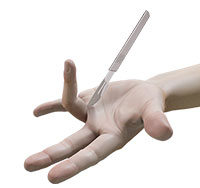 Hand surgery is performed to restore the structure and functionality of the fingers, wrist and hand secondary to a traumatic injury, medical condition, severe infection, or birth defect causing pain and/or deformity of the hand. It is performed by trained and certified plastic surgeons.
Hand surgery is performed to restore the structure and functionality of the fingers, wrist and hand secondary to a traumatic injury, medical condition, severe infection, or birth defect causing pain and/or deformity of the hand. It is performed by trained and certified plastic surgeons. -
Carpal Tunnel Release Surgery
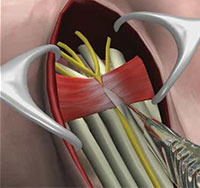 Carpal Tunnel Syndrome is a common, painful, progressive condition that is caused by compression of the median nerve at the wrist area. Common symptoms of carpal tunnel syndrome include numbness and tingling sensation in all the fingers except little finger; pain and burning sensation in hand and wrist that may radiate up the arm and elbow; and weakness in hand with diminished grip strength.
Carpal Tunnel Syndrome is a common, painful, progressive condition that is caused by compression of the median nerve at the wrist area. Common symptoms of carpal tunnel syndrome include numbness and tingling sensation in all the fingers except little finger; pain and burning sensation in hand and wrist that may radiate up the arm and elbow; and weakness in hand with diminished grip strength. -
Endoscopic Carpal Tunnel Repair
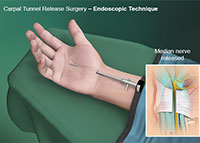 Carpal tunnel syndrome can be treated with carpal tunnel release surgery. Traditional surgery involves up to a two-inch incision in the palm and wrist area, whereas endoscopic surgery involves one or two half-an-inch incisions and the use of an endoscope. During the surgery, the transverse carpal ligament will be dissected to release the pressure on the median nerve and enlarge the carpal tunnel. Your surgeon will decide which options are best for you based on your general and medical conditions.
Carpal tunnel syndrome can be treated with carpal tunnel release surgery. Traditional surgery involves up to a two-inch incision in the palm and wrist area, whereas endoscopic surgery involves one or two half-an-inch incisions and the use of an endoscope. During the surgery, the transverse carpal ligament will be dissected to release the pressure on the median nerve and enlarge the carpal tunnel. Your surgeon will decide which options are best for you based on your general and medical conditions. -
Repair of Fractures
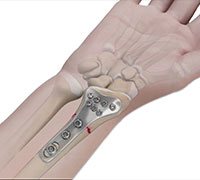 The wrist is comprised of two bones in the forearm, the radius and ulna, and eight tiny carpal bones in the palm. The bones meet to form multiple large and small joints. A wrist fracture refers to a break in one or more of these bones.
The wrist is comprised of two bones in the forearm, the radius and ulna, and eight tiny carpal bones in the palm. The bones meet to form multiple large and small joints. A wrist fracture refers to a break in one or more of these bones. -
Joint Fusions of the Fingers & Wrist
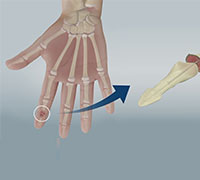 Joint fusion is a surgical procedure that involves removal of the damaged ends of the joint and fusing them together. Fusion prevents the movement of the joint and allows it to realign by itself.
Joint fusion is a surgical procedure that involves removal of the damaged ends of the joint and fusing them together. Fusion prevents the movement of the joint and allows it to realign by itself. -
Arthritis Surgery for Thumb and Digits
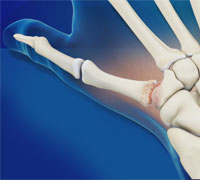 Arthritis is an inflammatory condition of joints. There are several types of arthritis; the most common type is osteoarthritis or wear-and-tear arthritis that affects the joint at the base of the thumb. Thumb arthritis is more common in women than men, and usually occurs after the age of 40 years.
Arthritis is an inflammatory condition of joints. There are several types of arthritis; the most common type is osteoarthritis or wear-and-tear arthritis that affects the joint at the base of the thumb. Thumb arthritis is more common in women than men, and usually occurs after the age of 40 years. -
Wrist Arthroscopy
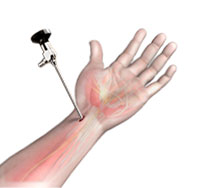 Your wrist is a complex joint made up of eight small bones called carpal bones. These bones are supported by connecting ligaments. Various conditions can affect your wrist joints such as carpal tunnel syndrome, osteoarthritis and others.
Your wrist is a complex joint made up of eight small bones called carpal bones. These bones are supported by connecting ligaments. Various conditions can affect your wrist joints such as carpal tunnel syndrome, osteoarthritis and others. -
Wrist Joint Replacement
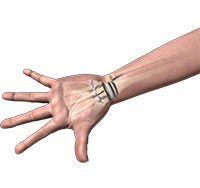 Wrist joint replacement surgery, also referred to as total wrist arthroplasty, involves replacement of a severe arthritic wrist joint with an artificial joint made of metal and plastic components. It relieves pain and restores function when conservative treatment fails to provide relief.
Wrist joint replacement surgery, also referred to as total wrist arthroplasty, involves replacement of a severe arthritic wrist joint with an artificial joint made of metal and plastic components. It relieves pain and restores function when conservative treatment fails to provide relief. -
Wrist Ligament Reconstruction
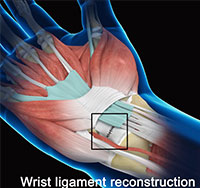 The human wrist is made up of small bones joined together by a band of tough fibrous tissue known as ligaments. Ligaments also join the bones in our wrist to the radius, ulna, and metacarpal bones, and aid in the proper functioning of our wrist. Any injury to the ligaments disturbs the normal alignment of our wrist bones causing them to wear out faster resulting in significant pain and eventually leading to arthritis.
The human wrist is made up of small bones joined together by a band of tough fibrous tissue known as ligaments. Ligaments also join the bones in our wrist to the radius, ulna, and metacarpal bones, and aid in the proper functioning of our wrist. Any injury to the ligaments disturbs the normal alignment of our wrist bones causing them to wear out faster resulting in significant pain and eventually leading to arthritis. -
Hand Therapy
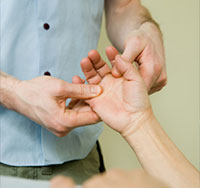 Hand Therapy is a rehabilitation technique recommended to improve the strength and restore the functional activity of hands in patients with upper extremity injuries. Hand therapy also helps in preventing the injury.
Hand Therapy is a rehabilitation technique recommended to improve the strength and restore the functional activity of hands in patients with upper extremity injuries. Hand therapy also helps in preventing the injury. -
Tendon Transfer
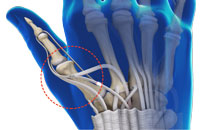 Tendon transfer surgery is a surgery to restore the lost functions of the hand by shifting functioning tendon from its initial attachment to the new one.
Tendon transfer surgery is a surgery to restore the lost functions of the hand by shifting functioning tendon from its initial attachment to the new one. -
Microsurgery
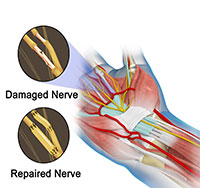 The hand is considered one of the most complex structures in the human body due to its intricate anatomy. Your hands are a complex system of various bones, joints, ligaments, tendons, muscles, nerves and blood vessels. Without the healthy functioning of the hand, we are unable to perform activities of daily living. The hand is one part of the body that is very susceptible to injury or disease.
The hand is considered one of the most complex structures in the human body due to its intricate anatomy. Your hands are a complex system of various bones, joints, ligaments, tendons, muscles, nerves and blood vessels. Without the healthy functioning of the hand, we are unable to perform activities of daily living. The hand is one part of the body that is very susceptible to injury or disease. -
Hand Rejuvenation
 Cosmetic enhancement is generally focused only on the face, while the hands portray some of the most prominent signs of aging . With age, the hands lose their firmness and plumpness and can appear bony and fragile. Hand rejuvenation is a treatment that gives you visibly younger, healthy, and firmer hands. If you want to diminish wrinkles, fight against the skin agingprocess, and improve the overall appearance of your hands, hand rejuvenation may be something to consider.
Cosmetic enhancement is generally focused only on the face, while the hands portray some of the most prominent signs of aging . With age, the hands lose their firmness and plumpness and can appear bony and fragile. Hand rejuvenation is a treatment that gives you visibly younger, healthy, and firmer hands. If you want to diminish wrinkles, fight against the skin agingprocess, and improve the overall appearance of your hands, hand rejuvenation may be something to consider. -
Hand Peripheral Nerve Surgery
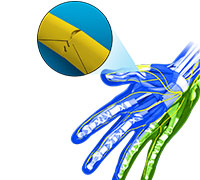 The peripheral nerves are the nerve fibres that compose the area from head to toe, connecting the brain and spinal cord with the rest of the body parts. Nerves transmit electrical impulses and signals to and from the brain. Peripheral nervous system disorders interrupt the transmission of signals and weaken the sensory and motor nerve functions. Unlike the brain and spinal cord, peripheral nerves have an inherent capacity for healing and regeneration.
The peripheral nerves are the nerve fibres that compose the area from head to toe, connecting the brain and spinal cord with the rest of the body parts. Nerves transmit electrical impulses and signals to and from the brain. Peripheral nervous system disorders interrupt the transmission of signals and weaken the sensory and motor nerve functions. Unlike the brain and spinal cord, peripheral nerves have an inherent capacity for healing and regeneration. -
Scapho-lunate Reconstruction – ANAFAB
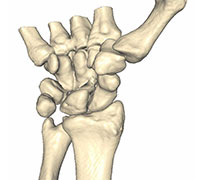 Disclaimer: Limited longer term results are available for this procedure. Any use of the technique is at the discretion of the treating Surgeon. The lack of wide spread experience must be considered in any decision to use the procedure – and such details should be disclosed to the patient.
Disclaimer: Limited longer term results are available for this procedure. Any use of the technique is at the discretion of the treating Surgeon. The lack of wide spread experience must be considered in any decision to use the procedure – and such details should be disclosed to the patient.
